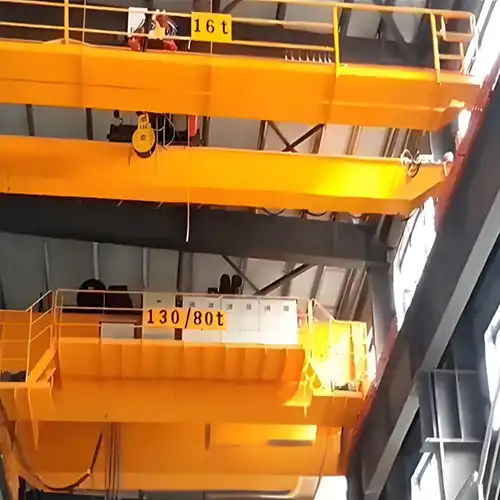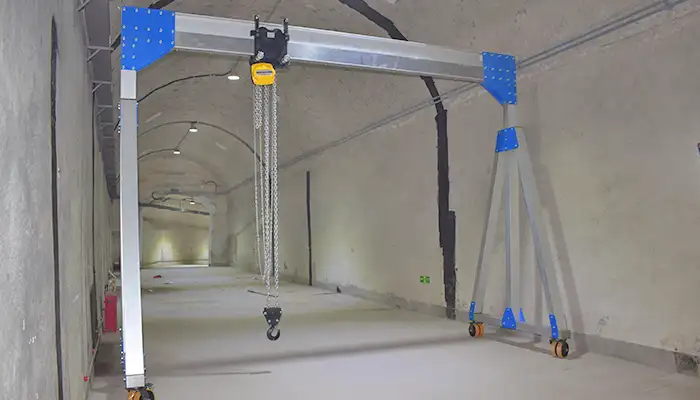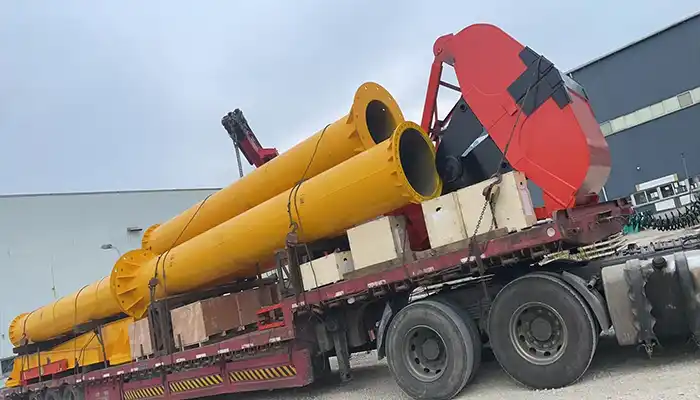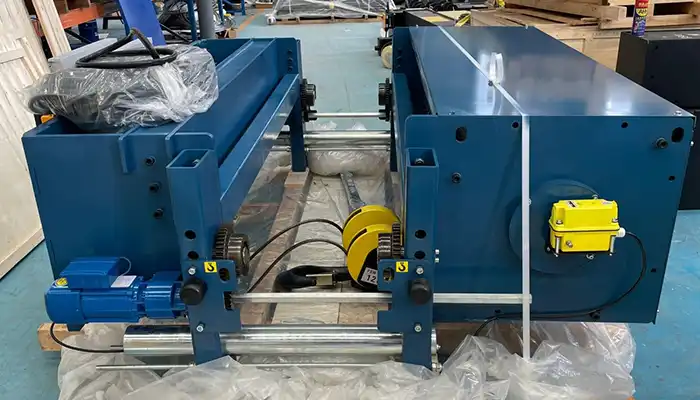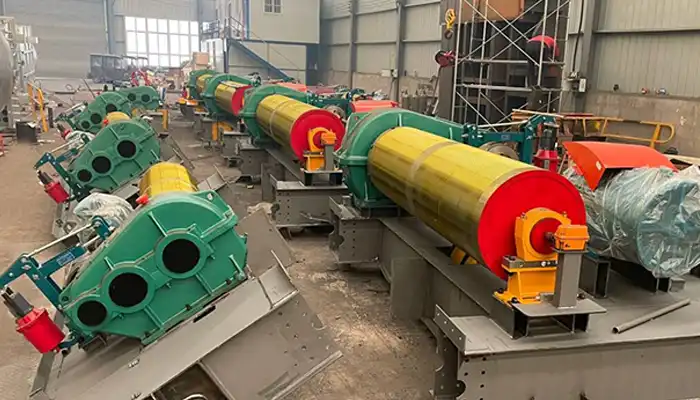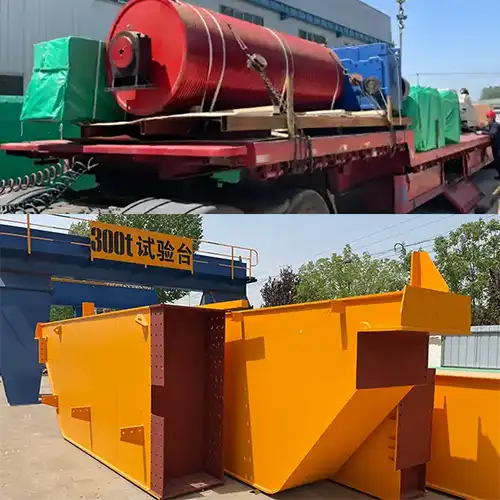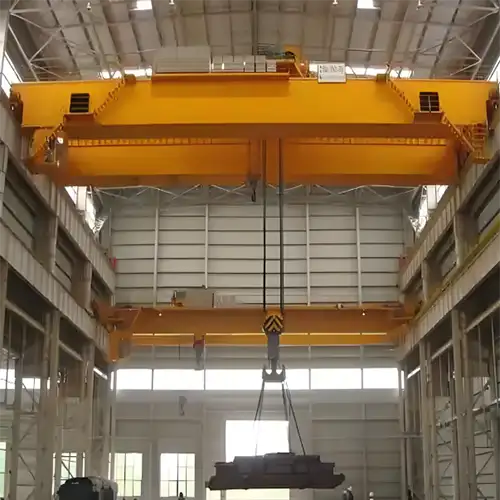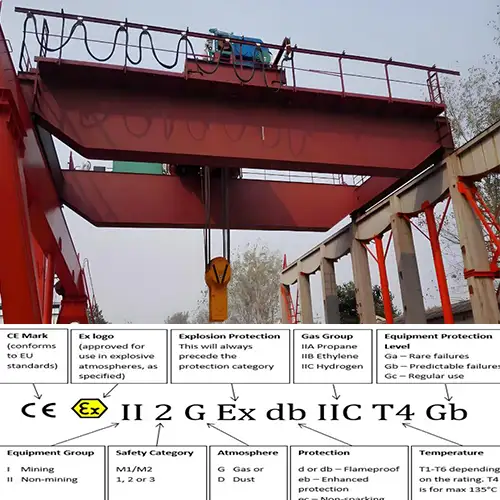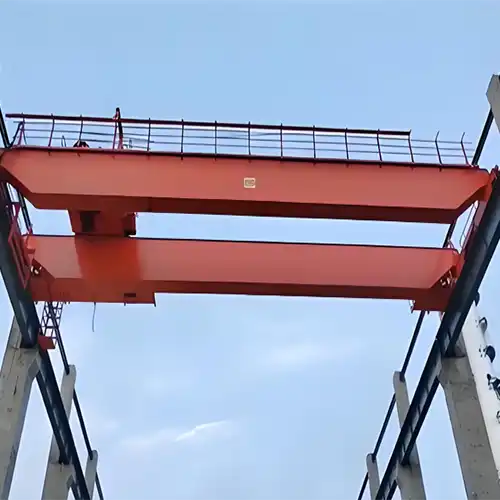16 T & 130/80 Ton Overhead Cranes in One Bay, Smart Lifting Crane
Heavy duty overhead cranes 130 ton/ 80 Ton, 16 ton designed for heavy & light lifting needs, optimizing workflow and space within a single workshop bay.
Category: Heavy Duty & Large Capacity
Your Trusted Heavy Lifting Overhead Crane Manufacturer & Supplier
Dual-Capacity Overhead Crane Setup: 16 Ton and 130/80 Ton Overhead Bridge Cranes in One Bay
A Customized Heavy Duty Overhead Crane Solution for Smarter Workshop Lifting
Introduction: The Challenge of Diverse Lifting Needs in One Workshop
Modern workshops are no longer doing just one thing. They lift, move, position, and assemble different types of loads every day. And not all those loads are the same. Some are light and frequent. Others are extremely heavy and handled only a few times a day—but they're critical.
This mix creates a serious challenge when using a single overhead crane for everything.
Why One Crane Often Isn't Enough
Let's say you have a workshop where workers need to lift steel parts, machine components, and large molds. If all of this depends on one crane, here's what usually happens:
- The heavy-duty crane is used even for light loads, which is inefficient and increases wear.
- Lighter jobs have to wait when the big crane is busy or parked at the other end.
- Operators spend more time coordinating moves instead of actually getting work done.
- The whole workflow becomes slower and more complex.
That's not a smart use of resources. And in today's competitive manufacturing world, time is money.
Flexibility and Space Optimization Are Key
Workshops don't always have space to add more equipment. In many cases, especially in older buildings or busy production lines, there's just one working bay available. So how do you make the most of it?
The answer lies in flexible crane systems—installing more than one overhead crane in the same bay, each with a different purpose. This way, you don't rely on one crane to do everything.
- Lighter cranes handle quick, daily tasks like lifting tooling, fixtures, or steel parts.
- Heavy-duty cranes handle occasional but critical lifts, such as molds, presses, or large machine frames.
- Both cranes can operate in the same bay without interrupting each other—if designed properly.
Now you're using your space wisely and working smarter, not harder.

Why a Dual-Capacity Crane System Works
A great example is combining a 16-ton overhead bridge crane with a 130/80-ton double girder crane. The 16-ton crane covers most of the regular work. It's faster, easier to handle, and uses less power. The 130/80-ton crane is there for the tough jobs—big lifts that require slow, precise movement and high safety.
This combination:
- Improves your overall lifting efficiency
- Reduces downtime and equipment strain
- Makes better use of your space and runway beam
- Increases safety by using the right crane for each task
Every workshop is different. That's why this solution works best when it's custom-designed. The crane speeds, spans, controls, and anti-collision systems all need to work together. You also want smooth movement, no interference, and safety features in place.
We design and supply crane systems based on your real conditions—not just standard models. Whether you're upgrading or building new, we'll help you match crane capacity, usage, and layout perfectly.
Why Combine 16 Ton and 130/80 Ton Overhead Cranes in the Same Bay?
Many workshops today face a common issue—how to handle a wide range of lifting tasks using limited space and equipment. You may have frequent, light-duty lifting needs, but also need to occasionally move very large, heavy items like molds or machines. Using just one crane for both tasks often causes delays, inefficiencies, and unnecessary wear on your equipment.
That's why combining a 16-ton overhead crane with a 130/80-ton double girder crane in the same working bay is a smart solution. This approach helps you manage space, improve workflow, and boost productivity.
Efficient Use of Space
Space is one of the most expensive parts of any factory or workshop. In many cases, especially in existing buildings, there's no room to add another crane runway or build a separate bay just for heavy lifting.
By running both cranes on the same runway beam, you make better use of the space you already have. Here's how:
- Both cranes can operate within the same span, but at different times or in different working zones.
- Each crane can be designed with custom lifting heights, so they don't interfere with one another.
- Infrastructure such as columns, rails, and power supplies can be shared, reducing cost and installation complexity.
- You avoid wasting headroom or floor area just to accommodate separate systems.
This layout works especially well when planned in advance or during a crane upgrade project.
Operational Flexibility
In day-to-day operations, not every load requires a massive crane. It's often faster and safer to handle smaller loads with a smaller crane. A 16-ton crane is much easier to operate, requires less energy, and can be used for a wide variety of routine tasks.
Meanwhile, the 130/80-ton double girder crane can be reserved for high-value, heavy-duty lifts. These usually require careful setup, trained operators, and sometimes slower speeds.
With both cranes available in the same bay:
- Operators don't have to wait for the big crane to become free to complete simple lifting tasks.
- Smaller items don't need to be manually moved or transferred to another bay.
- You can run more than one lifting job at a time, depending on layout and safety systems.
- The workload is divided, which extends the service life of both cranes.
This setup brings true flexibility to your production process.
Increased Productivity
When one crane is doing all the work—light and heavy—you'll quickly run into delays. A large-capacity crane is built for strength, not speed. Using it for light lifting tasks is inefficient and increases wear.
Separating the work between two cranes based on load weight and task type leads to:
- Faster handling of daily lifting jobs
- Less waiting time between tasks or shifts
- Reduced strain on the heavy-duty crane
- Improved workflow and team coordination
The result is a smoother, more predictable production process, especially in multi-stage operations like steel structure fabrication or equipment assembly.
Use Cases in the Same Workshop
Let's look at how each crane might be used in a real-world workshop.

16 ton overhead bridge crane, double girder overhead crane for sale

130/80 ton overhead crane
The 16-ton overhead crane is typically used for:
- Moving parts, components, and tooling between workstations
- Handling jigs, welding frames, and light steel beams
- Loading and unloading smaller materials from trucks or storage
- Supporting assembly work that needs frequent repositioning
On the other hand, the 130/80-ton overhead crane is responsible for:
- Lifting and positioning large casting molds or dies
- Moving heavy machinery or large structural frames
- Supporting equipment installation or removal
- Handling large welded assemblies during final inspection or transfer
Each crane has a clear role, and together they cover the full range of lifting demands in the workshop—without stepping on each other's toes.
Designed for Safety and Smooth Operation
Of course, combining two cranes in the same bay requires careful engineering. This includes:
- Defining separate work zones or installing anti-collision devices to prevent accidents
- Adjusting hook heights to avoid mechanical interference
- Coordinating crane travel speeds and control systems
- Ensuring electrical compatibility and proper spacing on the runway beam
When done right, the system is safe, reliable, and easy to operate. The two cranes support each other, instead of competing for space.
We offer custom solutions based on your actual production needs, lifting requirements, and site conditions. Whether you're planning a new workshop or upgrading an existing one, our team ensures your cranes work together seamlessly.
Key Design Considerations for a Multi-Capacity Overhead Bridge Crane Bay
Installing both a 16-ton and a 130/80-ton overhead bridge crane in the same working bay is not as simple as mounting them on the same rails. The entire system must be carefully designed to ensure the overhead cranes operate safely and efficiently, without conflict or downtime. Below are the main design areas to focus on when customizing a multi-capacity bridge crane setup.
Crane Compatibility
When two overhead cranes operate in the same bay, they must be fully compatible in function and design.
- Each bridge crane may have different hoist systems—smaller units often use compact electric hoists, while the larger 130/80-ton overhead bridge crane will typically use an open winch system.
- Lifting speeds, acceleration, and braking must be considered. The 16-ton overhead crane may be faster, while the heavy-duty crane is slower and more controlled.
- Hook approaches, lifting height, and end carriage dimensions must be coordinated to avoid mechanical interference.
This level of planning ensures both overhead cranes can share the same space without disrupting each other's operation.
Runway Beam Configuration
The runway system must be engineered to support both light and heavy bridge cranes. Although they share the same track, their effects on the structure are quite different.
- The 130/80-ton overhead bridge crane applies significantly higher wheel loads to the runway beam and support columns.
- The lighter 16-ton overhead crane still needs smooth and stable travel to prevent rail misalignment or premature wear.
- Structural checks must ensure the runway can handle combined live loads, especially if the cranes operate frequently or simultaneously.
A strong, balanced runway system is critical to long-term performance and safety.
Anti-Collision Systems
When two overhead cranes are installed in the same bay, anti-collision becomes a priority for safe operation.
- Install non-contact sensors or laser rangefinders to prevent the bridge cranes from colliding.
- Set up travel limiters that automatically stop the crane when it gets too close to another crane in the bay.
- Some systems also allow you to define no-entry zones or delay one crane when the other is active nearby.
With proper anti-collision design, your overhead bridge crane system can run safely and smoothly—even when more than one operator is working at a time.
Electrical Integration
Your electrical setup must support both overhead cranes without overload or interference.
- Provide a reliable power distribution system that can handle high startup currents from the 130/80-ton bridge crane.
- Separate control panels or remote controls for each crane reduce confusion and improve operator safety.
- Use surge protection and line filters to avoid voltage drops when both cranes are operating.
- Centralized monitoring helps detect and fix faults faster, which is especially useful in heavy-use industrial overhead crane applications.
Proper electrical planning ensures your entire crane system runs with minimal interruption.
Operator Visibility and Control Interface
Controlling two overhead cranes in the same bay requires clear visibility and ergonomic control.
- The 16-ton bridge crane can be operated by handheld remote or pendant control, allowing fast movement and high precision for smaller loads.
- The 130/80-ton overhead bridge crane may need a cabin or video-assisted control for better visibility when lifting massive items.
- Visual cues such as LED indicators, alarm buzzers, and limit zone lights help avoid mistakes in overlapping zones.
Giving operators good control over each overhead crane increases both safety and productivity.
A shared crane bay with multiple capacities—like a 16-ton and 130/80-ton overhead bridge crane—offers great flexibility, but only if it's properly designed.
From structural strength to electrical integration and operator controls, every detail matters. When done right, your overhead crane system becomes a reliable backbone of your workshop, capable of handling both routine lifts and the heaviest critical loads.
We specialize in customized overhead bridge crane systems tailored to your actual needs. Whether you're starting fresh or upgrading an existing workshop, we make sure every bridge crane in your bay is fully compatible and future-ready.
Custom Engineering for Your Heavy Lifting
Every workshop is different. That's why off-the-shelf cranes often don't work well in complex environments—especially when you need both a standard-capacity and a heavy-duty overhead bridge crane in the same bay.
We offer custom engineering solutions built to match your real-world conditions.
Tailor-Made Crane Systems
We don't just supply standard models. We design each overhead crane system based on your actual workshop layout, lifting needs, and load characteristics.
- Whether you're handling machine parts with a 16-ton bridge crane or lifting steel molds with a 130/80-ton unit, the design is based on what really happens on your shop floor.
- We account for hook travel, lifting height, bay width, and any obstacles that may affect crane motion.
- Our engineering team works directly with your layout drawings to create a custom-fit overhead bridge crane system—no guessing, no waste.
The result is better use of space and smoother operation from day one.
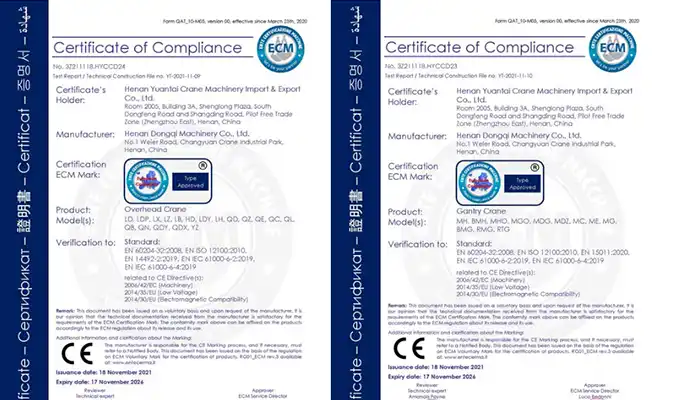
CE & ISO Certified Designs
All of our overhead cranes are built to meet international quality and safety standards.
- Our equipment carries CE certification, meeting European Union safety and performance rules.
- We also follow ISO standards in our design, manufacturing, and testing processes.
- Each crane goes through strict quality control and can be third-party inspected if required.
This gives you peace of mind, especially when installing high-capacity cranes in demanding environments.
Advanced Anti-Collision Devices
When multiple bridge cranes share the same runway, safety is a top concern. That's why we equip your system with advanced anti-collision technology.
- Laser sensors or radar-based devices detect the position of other cranes in real time.
- The system can slow down or stop one crane automatically if another is too close.
- Anti-collision devices help avoid accidents, especially in busy workshops where two operators may be working at the same time.
It's a small investment for a big increase in safety and peace of mind.
Synchronization and Zoning Options
For added control and automation, we offer optional features that help you run your overhead crane system more efficiently.
- Synchronization allows both main and auxiliary hoists (like in a 130/80-ton crane) to move together with precision. This is useful for lifting large or awkward items.
- Zoning control can limit a crane's movement to certain areas, preventing it from entering other work zones.
- These options improve safety, reduce operator error, and support smoother, semi-automated crane operations.
Whether you're lifting daily or only on demand, these features can be added to match your workflow.
Built Around Your Needs
Custom engineering isn't just about choosing a tonnage or a model. It's about making sure your overhead bridge crane system is the right tool for your job—today and tomorrow.
We work with you from layout planning to final installation to make sure every detail fits. Our goal is to deliver cranes that work hard, work safe, and work smart.
Benefits of Customized Dual-Crane Systems
Installing both a 16-ton and a 130/80-ton overhead bridge crane in one bay isn't just about lifting capacity. It's about creating a smarter, safer, and more productive workspace. When planned and engineered correctly, a dual-crane system brings real benefits to your daily operations.
Reduced Downtime
When you separate lifting tasks between two overhead cranes, your work doesn't have to stop and wait.
- The 16-ton bridge crane can handle quick, frequent lifts like components, jigs, or fixtures.
- Meanwhile, the 130/80-ton heavy-duty overhead crane can be reserved for big loads—like molds, large equipment, or structural steel.
- Both cranes can work at the same time in different zones of the bay, which keeps production moving.
This setup helps avoid bottlenecks and improves your total handling speed.
Safety Assurance
A customized system isn't just efficient—it's safer.
- Each overhead crane is engineered to work within a set path or zone, reducing risk of collision.
- With anti-collision devices and zoning control, two operators can run their cranes without stepping into each other's space.
- Hoisting speeds, braking systems, and travel limits are designed for the exact tasks each crane will handle.
This means fewer accidents and safer lifting—day after day.
Long-Term Cost Savings
Better planning now can save you serious money later.
- A dual-crane system makes better use of your existing bay, so there's no need to build a separate structure for heavy lifting.
- Your overhead bridge crane runway beams are shared, reducing installation costs and structural materials.
- If your needs change in the future, you already have a flexible setup that can adapt to new workflows.
This is a long-term investment that protects your space and your budget.
Improved Workflow Efficiency
Having two cranes with different roles brings structure and logic to your lifting process.
- Lighter work goes to the smaller overhead crane—quicker, more precise, and easier to handle.
- Heavy, critical lifts are done with the larger bridge crane—safe, powerful, and reliable.
- This task separation keeps operators focused and reduces time spent waiting for a crane to become available.
The result? Smoother operations, faster turnaround, and less stress on your team.
A Smarter Setup for Modern Workshops
Whether you run a steel fabrication shop, machinery plant, or mold workshop, a custom dual-crane system gives you the right tools for the job. It's not just about lifting more—it's about lifting smarter.
Our factory specializes in designing overhead crane systems that match your exact layout, load types, and workflow. We help you get the most out of your space—with safety, speed, and savings in mind.
Is This Setup Right for Your Workshop? Key Questions to Ask
A dual-capacity crane setup isn't for everyone. But if you're running into space limitations, production delays, or a mix of light and heavy lifting needs, this kind of system could be the right move. Before deciding, here are a few practical questions to help you evaluate your situation.
1. Do you have both heavy and light lifting tasks in the same production bay?
If you're currently using a single overhead crane to handle everything—from small parts to large equipment—you might be wasting time and wearing out your main crane too fast.
- A dedicated 16-ton bridge crane can take care of daily tasks more efficiently.
- The heavy-duty 130/80-ton overhead bridge crane can focus on major lifts only.
This split keeps both cranes in their optimal working range and extends equipment life.
2. Is your workshop space already tight or fully built up?
If adding a new bay isn't an option, combining two cranes into one shared working area may be your best use of vertical and horizontal space.
- This approach avoids structural expansion.
- You get full lifting coverage without needing to rebuild your plant.
A shared overhead crane runway saves both money and space—especially valuable in older or high-density workshops.
3. Is future scalability or equipment upgrade important for you?
Think long-term. A dual-crane system is easier to upgrade.
- If your production grows, you can increase lifting frequency without overloading a single crane.
- You can replace or upgrade just one crane at a time, not the entire system.
This gives you more flexibility and control over future investments.
4. Are you facing productivity delays due to single-crane dependency?
If work often stops because the crane is busy or unavailable, that's a red flag.
- Separate cranes for different tasks reduce waiting time.
- Teams can work in parallel without interfering with each other.
This boosts overall workflow and keeps your production line moving without costly interruptions.
Partner with Yuantai Crane for Smart, Scalable Workshop Cranes
Choosing the right partner for your overhead bridge crane project makes all the difference—especially when you're dealing with a custom, dual-capacity setup. At Yuantai Crane, we don't just supply cranes—we build solutions that match your real workshop needs, now and into the future.
Proven Experience with Dual-Capacity Systems
We've helped workshops across industries install 16-ton and 130/80-ton bridge cranes in the same bay.
- From mold factories to machinery plants, we understand how to balance lifting demands.
- Our team knows what to look for—clearances, runway loads, electrical coordination, and more.
- We work closely with your team to make sure every crane fits and functions properly.
You don't need to explain everything—we speak your language and know what questions to ask.
One-Stop Crane Service from Start to Finish
We take care of everything so you don't have to manage multiple vendors.
- Overhead crane system design tailored to your layout and workflow.
- In-house manufacturing with strict quality control.
- Pre-delivery testing, third-party inspection (if needed), and installation guidance.
- Help with runway beam design, hoist configuration, and power supply matching.
From the first drawing to the final bolt, you get complete support.
Trusted by Global Clients
Yuantai Crane serves customers across Asia, Europe, the Middle East, and beyond.
- Our custom overhead cranes are used in steel plants, foundries, workshops, and logistics hubs.
- We've hosted thousands of clients at our factory in Xinxiang, China.
- Many have returned for second and third projects as their production needs grew.
Your success is our best case study.
Support for Long-Term Use and Growth
We build crane systems that last—and grow with your business.
- Spare parts, technical advice, and upgrade options are always available.
- Need a higher lifting capacity later? We can help you plan for it now.
- Our team is here to support you long after the crane is installed.
You're not just buying a bridge crane—you're building a long-term partnership.
Let's Build the Right Crane for Your Workshop.If you're looking for a smart way to handle both light and heavy lifting in one bay, Yuantai Crane is ready to help. We'll deliver a system that saves you space, time, and future headaches.
Contact Us for a Custom Quote & Technical Assessment
Ready to upgrade your workshop with a tailored overhead bridge crane solution? Here's how to get started with Yuantai Crane:
What We Need From You
- Workshop Layout or Drawings
Provide floor plans, runway beam details, or even sketches/photos. - Load Information
Types of loads (molds, machinery, steel parts) and their weights. - Crane Usage Frequency
How often will the cranes operate? (Daily, occasional, continuous) - Existing Crane Systems
Details of any current bridge cranes or runway beams in use.
What You'll Receive
- A customized overhead crane system design tailored to your space and lifting needs.
- A detailed, transparent quote.
- Expert recommendations on safety features, anti-collision systems, and electrical setup.
- Advice on future scalability and upgrades if needed.
Send us your information and let our team handle the technical assessment and design proposal—completely free and without obligation.Contact Yuantai Crane today.
Let's build the right heavy lifting crane system for your workshop.
Main Projects
Related Products
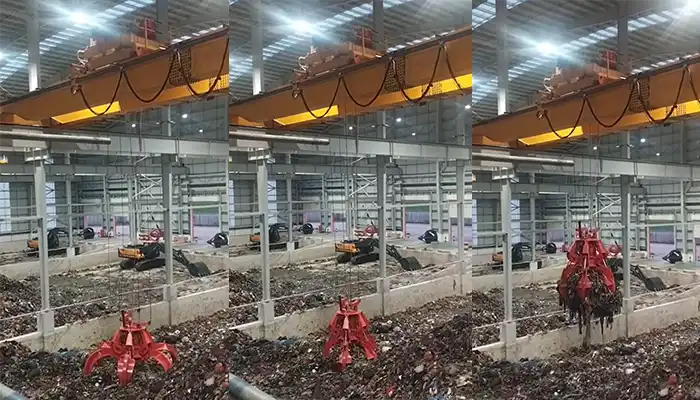
Supplied three grab bucket crane kits to Indonesia, enhancing garbage handling efficiency with high load capacity and reliable performance.
Free consultation to Confirm Parameters & Specifications and Get
Latest Crane Price & Crane Rate.
- Types of overhead cranes : _______?
- Optional: Overhead travelling crane, goliath gantry crane,Slewing jib crane, Single girder or double girder crane,small portable crane or kbk crane, etc.
- Capacity of overhead crane: _______?
- Optional: 0.25ton, 0.5 ton, 1 ton, 2 ton, 3ton, 5 ton, 10 ton,15ton, 20ton, 25 ton, 30ton,35ton, up to 550ton, etc.
- Crane span & lifting height : _______?
- Crane travelling length : _____?
- Control of overhead crane:_______?
- Optional: pendant/ remote/cabin control
- Voltage supply of overhead crane:_____?
- Eg,: 380V50/60HZ,3Phase or others,etc.
- Application/usage of crane:_______?
- Eg,: Steel mill, ,injection mold, cement,stone, concrete,granite, general manufacturing, etc.
Just leave a message via the contact form and our hoist and crane engineer will contact you with in 24working hours.
Get In Touch
